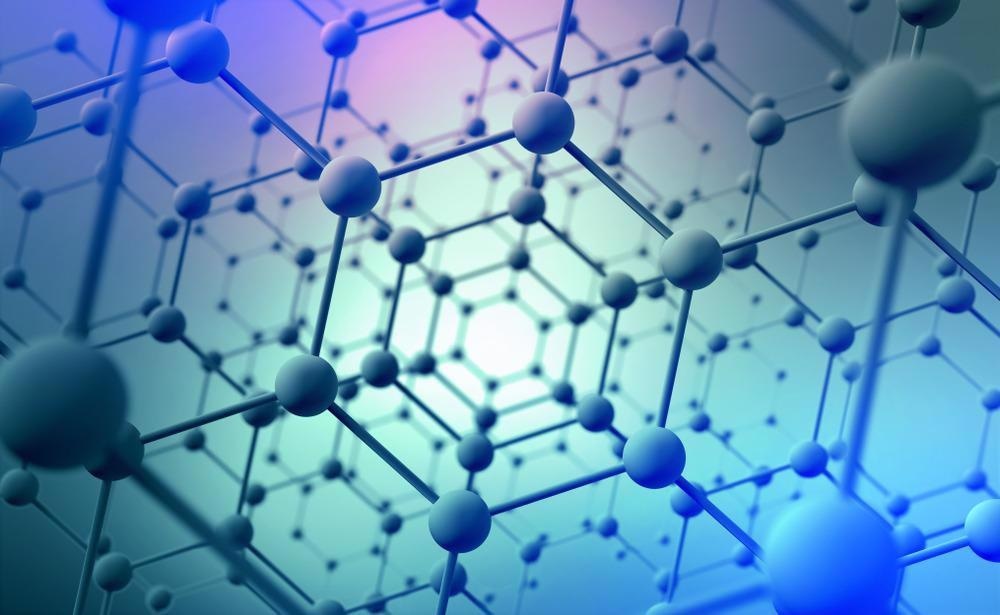Piezocatalytic materials offer a wide range of applications in wireless therapies. In a study published in the journal ACS Applied Materials & Interfaces, anisotropic geometry and gold nanoparticle (Au NP) incorporation were demonstrated to improve the piezocatalysis ability of calcium phosphate (Ca3(PO4)2) nanomaterial by tenfold, and the behavior matched that of the renowned bulk/NP form of Barium titanate (BaTiO3).

Study: Enhanced Piezocatalysis by Calcium Phosphate Nanowires via Gold Nanoparticle Conjugation. Image Credit: Yurchanka Siarhei/Shutterstock.com
The Potential of Piezoelectric Nanomaterials
Piezoelectric nanoparticles are being developed as a novel kind of intelligent material with potential in energy collection, ecological restoration, and enhanced biomedical solutions. The employment of piezoelectric nanoparticles in biomedicine studies has particularly received a lot of interest.
These nanoparticles can produce chemical energy from mechanical energy and trigger electrolytic surface reactions by using small frequency oscillations such as ultrasound. This property has enormous bio-medicinal usage possibilities due to its non-invasive nature and ability to penetrate deep tissue.
The Main Hurdle in the Way of Piezoelectric Nanomaterials
Since ultrasound has broader medicinal applicability, spanning from ultrasonography-based illness diagnostics to treatment, ultrasound-induced piezocatalytic therapy may be used for a variety of biological applications. Traditional high-performing piezoelectric substances are made of cytostatic lead (such as lead zirconium titanate) and are unsuitable for biomedical activities.
The quest for alternate nanoscale materials such as ZnO, BN nanotubes, MoS2, and BaTiO3 has therefore persisted. Nonetheless, in comparison with industry-grade lead-based substances, the piezocatalysis of these identified nanoscale materials is significantly reduced. As a result, there is a continued focus on developing better piezocatalytic NPs.
Piezoelectric materials are turned into aqueous nanoparticles with shown uses for remote nerve cells stimulation, cell/cancer treatment, nerve stem cell fate management, cell distinction, teeth brightening usage, and amyloid (Aβ) fibril breakdown.
How can the Piezocatalytic Performance be Enhanced?
The effectiveness of a piezocatalytic NP decreases with nanoparticle diameter but can be increased by creating composites with highly conductive 2D materials (such as BN nanosheets) or conjugating with metallic NPs; or forming polymeric composites.
Attaching metal NPs to piezoelectric materials particularly improves piezocatalysis performance in two different ways. Whenever the piezo potential is formed in ultrasonic exposure, the connected metal NP at the face of the piezoelectric substance produces an effective splitting of holes and electrons.
The incorporation of metal NPs into the piezoelectric substance causes a higher mismatch of charges on the surface all along the polar axis, hence improving the piezoelectric characteristic.
Calcium Phosphate for Biomedical Applications
Calcium phosphate (Ca3(PO4)2) is a popular biomaterial, nanoparticles of which are employed for regenerating bones and cartilage and for other medicinal purposes. In vivo as well as in vitro, polarized hydroxyapatite nanoscale structures have been shown to promote the formation of bone-like apatite.
Its piezoelectric effect, which converts an external input into a biologically identifiable cue for directing the formation and resorptive process, is responsible for such characteristics.
Electric polarization has a substantial impact on biomineralization in live species, and piezoelectric cues may affect collagen composition or be immediately linked to cellular activity.
Important Findings of the Study
In this study, the team demonstrated that the anisotropic nanowire architecture of Ca3(PO4)2, as well as the coating of gold NPs on its surface, may greatly improve piezocatalysis capabilities.
Colloidal Ca3(PO4)2 nanowires and nanorods with varying ratios of length to width, as well as their conjugates with gold NPs, were produced, and their piezoelectric capabilities were examined using piezo response force imaging.
It was discovered that anisotropic nanowire architecture of Ca3(PO4)2 can improve the piezoelectric effect twofold as opposed to nanospherical architectures and that gold NP incorporation can improve it tenfold, with a sustained piezoelectric value of 72 pm/V, that is comparable to the benchmark tetragonal BaTiO3. This improved piezoelectric capability has been proven to improve piezocatalysis processes tenfold.
Water-dissoluble and aqueous nanoscale composites were synthesized and turned into aqueous nanometric bioconjugates for specific tagging of tumor cells, accompanied by ultrasound-based remote cell treatment through subcellular reactive oxygen species (ROS) production.
Future Prospects
The technique shown here may be developed to create structures predicated on Ca3(PO4)2 for a variety of biomedical purposes.
Aqueous-functional NPs are particularly being developed for cellular tagging and targeting, accompanied by low ultrasound-based cellular treatment through subcellular ROS production. It is anticipated that this discovery will be used to develop and improve the currently inadequate piezocatalysis capability of biomedically pertinent nanostructures, as well as for other biological uses.
Disclaimer: The views expressed here are those of the author expressed in their private capacity and do not necessarily represent the views of AZoM.com Limited T/A AZoNetwork the owner and operator of this website. This disclaimer forms part of the Terms and conditions of use of this website.
Source:
Dolai, J., Biswas, A., Ray, R., & Jana, N. R. (2022). Enhanced Piezocatalysis by Calcium Phosphate Nanowires via Gold Nanoparticle Conjugation. ACS Applied Materials & Interfaces. Available at: https://doi.org/10.1021/acsami.2c05036